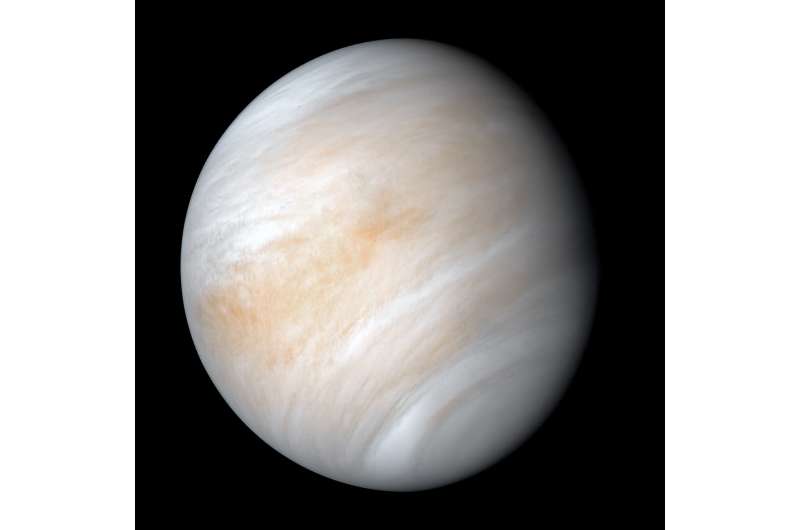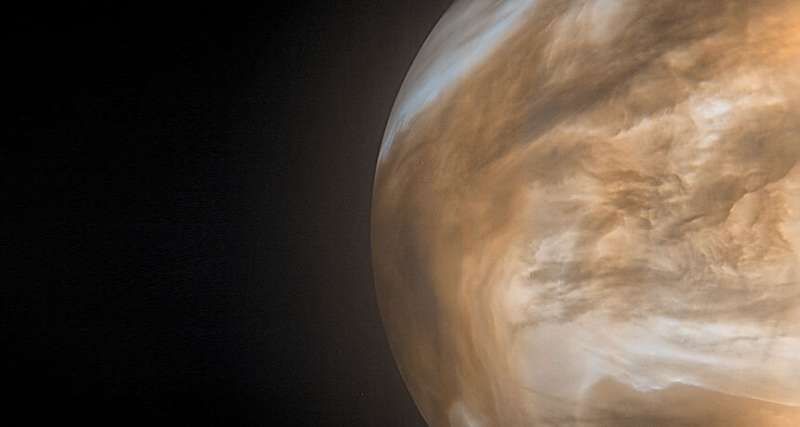As they report in a paper accepted to The Astrophysical Journal and posted Jan. 25 to the preprint site arXiv, the U.K.-led group likely wasn't detecting phosphine at all.
"Instead of phosphine in the clouds of Venus, the data are consistent with an alternative hypothesis: They were detecting sulfur dioxide," said co-author Victoria Meadows, a UW professor of astronomy. "Sulfur dioxide is the third-most-common chemical compound in Venus' atmosphere, and it is not considered a sign of life."
The team behind the new study also includes scientists at NASA's Caltech-based Jet Propulsion Laboratory, the NASA Goddard Space Flight Center, the Georgia Institute of Technology, the NASA Ames Research Center and the University of California, Riverside.
The UW-led team shows that sulfur dioxide, at levels plausible for Venus, can not only explain the observations but is also more consistent with what astronomers know of the planet's atmosphere and its punishing chemical environment, which includes clouds of sulfuric acid. In addition, the researchers show that the initial signal originated not in the planet's cloud layer, but far above it, in an upper layer of Venus' atmosphere where phosphine molecules would be destroyed within seconds. This lends more support to the hypothesis that sulfur dioxide produced the signal.
Both the purported phosphine signal and this new interpretation of the data center on radio astronomy. Every chemical compound absorbs unique wavelengths of the electromagnetic spectrum, which includes radio waves, X-rays and visible light. Astronomers use radio waves, light and other emissions from planets to learn about their chemical composition, among other properties.

In 2017 using the James Clerk Maxwell Telescope, or JCMT, the U.K.-led team discovered a feature in the radio emissions from Venus at 266.94 gigahertz. Both phosphine and sulfur dioxide absorb radio waves near that frequency. To differentiate between the two, in 2019 the same team obtained follow-up observations of Venus using the Atacama Large Millimeter/submillimeter Array, or ALMA. Their analysis of ALMA observations at frequencies where only sulfur dioxide absorbs led the team to conclude that sulfur dioxide levels in Venus were too low to account for the signal at 266.94 gigahertz, and that it must instead be coming from phosphine.
In this new study by the UW-led group, the researchers started by modeling conditions within Venus' atmosphere, and using that as a basis to comprehensively interpret the features that were seen—and not seen—in the JCMT and ALMA datasets.
"This is what's known as a radiative transfer model, and it incorporates data from several decades' worth of observations of Venus from multiple sources, including observatories here on Earth and spacecraft missions like Venus Express," said lead author Andrew Lincowski, a researcher with the UW Department of Astronomy.
The team used that model to simulate signals from phosphine and sulfur dioxide for different levels of Venus' atmosphere, and how those signals would be picked up by the JCMT and ALMA in their 2017 and 2019 configurations. Based on the shape of the 266.94-gigahertz signal picked up by the JCMT, the absorption was not coming from Venus' cloud layer, the team reports. Instead, most of the observed signal originated some 50 or more miles above the surface, in Venus' mesosphere. At that altitude, harsh chemicals and ultraviolet radiation would shred phosphine molecules within seconds.
"Phosphine in the mesosphere is even more fragile than phosphine in Venus' clouds," said Meadows. "If the JCMT signal were from phosphine in the mesosphere, then to account for the strength of the signal and the compound's sub-second lifetime at that altitude, phosphine would have to be delivered to the mesosphere at about 100 times the rate that oxygen is pumped into Earth's atmosphere by photosynthesis."
The researchers also discovered that the ALMA data likely significantly underestimated the amount of sulfur dioxide in Venus' atmosphere, an observation that the U.K.-led team had used to assert that the bulk of the 266.94-gigahertz signal was from phosphine.
"The antenna configuration of ALMA at the time of the 2019 observations has an undesirable side effect: The signals from gases that can be found nearly everywhere in Venus' atmosphere—like sulfur dioxide—give off weaker signals than gases distributed over a smaller scale," said co-author Alex Akins, a researcher at the Jet Propulsion Laboratory.
This phenomenon, known as spectral line dilution, would not have affected the JCMT observations, leading to an underestimate of how much sulfur dioxide was being seen by JCMT.
"They inferred a low detection of sulfur dioxide because of that artificially weak signal from ALMA," said Lincowski. "But our modeling suggests that the line-diluted ALMA data would have still been consistent with typical or even large amounts of Venus sulfur dioxide, which could fully explain the observed JCMT signal."
"When this new discovery was announced, the reported low sulfur dioxide abundance was at odds with what we already know about Venus and its clouds," said Meadows. "Our new work provides a complete framework that shows how typical amounts of sulfurdioxide in the Venus mesosphere can explain both the signal detections, and non-detections, in the JCMT and ALMA data, without the need for phosphine."
With science teams around the world following up with fresh observations of Earth's cloud-shrouded neighbor, this new study provides an alternative explanation to the claim that something geologically, chemically or biologically must be generating phosphine in the clouds. But though this signal appears to have a more straightforward explanation—with a toxic atmosphere, bone-crushing pressure and some of our solar system's hottest temperatures outside of the sun—Venus remains a world of mysteries, with much left for us to explore.
Explore further



